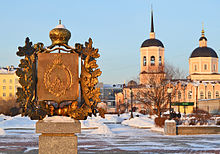Tomsk
[15] The Tsar sent 200 Cossacks under the command of Vasily Fomich Tyrkov [ru] and Gavriil Ivanovich Pisemsky to construct a fortress on the bank of the Tom River, overlooking what would become the city of Tomsk.
After the October Revolution of 1917, the city became a notable center of the White movement, led by Anatoly Pepelyayev and Maria Bochkareva, among others.
After the victory of the Red Army in the 1920s, Soviet authorities incorporated Tomsk into the West Siberian Krai and later into Novosibirsk Oblast.
[16] During the Cold War, Tomsk became one of many designated closed cities,[citation needed] which outsiders and, in particular, foreigners, could not visit.
In 1949 matters went a stage further with the establishment of a secret city, known as "Tomsk-7[17]" (or sometimes simply as "Postbox 5") 15 kilometres (9 miles) north-west of Tomsk; the new settlement became the home of the Tomsk Nuclear Plant (subsequently renamed the Sibirskaya Nuclear Power Plant), the Soviet Union's first industrial-scale nuclear-power station.
In 2006, Tomsk experienced what might have been its first recorded winds of hurricane force, which toppled trees and damaged houses.
In the October 2005 local elections, United Russia was expected to cruise to a solid victory; however, the Pensioners Party put up a strong showing.
A large number of educational institutions in the city have contributed to making Tomsk a major center for Russia's IT industry.
Tomsk was one of the first cities in Russia to gain access to the Internet, which became available in the early 1990s owing to grants received by universities and scientific cooperation.
Trains link Tomsk to Anapa, Asino, Barnaul, Bely Yar, Moscow, Novokuznetsk, Novosibirsk, Sochi, and Tayga.
Those who escaped the flames were gunned down by Black Hundred members waiting outside the theater.
[citation needed] There are a number of museums in Tomsk devoted to various subjects, most notably art, local history and wood carving.
Tomsk State University has a number of small museums with exhibits on archaeology, paleontology, zoology, as well as a herbarium and a botanical garden As in many other cities in the former Soviet Union, the revolutionary government destroyed a number of old churches in the city including two that had existed since the 17th century.
However, Tomsk managed to save some of its churches by transforming them into machine shops, warehouses, archives, and even residential buildings.
In April 2006 Tomsk received international media attention as the venue of a major summit on economic cooperation, held in the city between Russian President Vladimir Putin and German Chancellor Angela Merkel.







